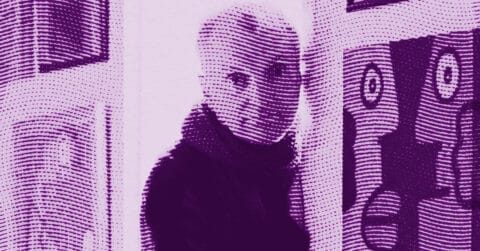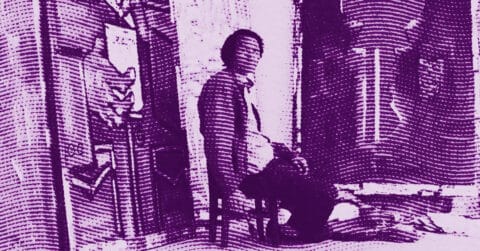Listen to me carefully, you bunch of snobs: Mira Schor paints as one writes a manifesto, writes as one paints a struggle, and within this dual practice lies the full power of her work. New York artist born in 1950, trained at the California Institute of the Arts where she participated in the legendary Womanhouse in 1972, Schor represents the generation of creators who refused to choose between thought and matter, between feminism and formalism. Her journey is part of a lineage of artist-theorists who understood that art could not be mute, and that words alone are not enough without the flesh of painting.
Schor’s work unfolds in a territory where language becomes image and where the image carries the weight of language. Her 1970s canvases, these Story Paintings created in California, depict nude women moving through lush landscapes, often accompanied by wild animals, notably bears. These compositions are not mere illustrations of a harmonious relationship with nature: they question the place of femininity outside the domestic frameworks historically assigned to it. The woman appears not as a creature to be tamed, but as a force that dialogues on equal terms with the wild. This vision resonates strongly in literature, particularly with authors who have explored the forbidden territories of female experience.
Charlotte Perkins Gilman, in her short story The Yellow Wallpaper published in 1892, describes a narrator who begins to crawl on all fours, adopting animal behaviors to escape the domestic confinement that drives her mad [1]. This foundational text of American feminist literature reveals how patriarchy associates the woman with the animal to better devalue her, to better confine her within the role of an irrational creature needing control and surveillance. But where Gilman exposes the pathology of an oppressive system, Schor proposes a reappropriation. In her Californian paintings, animality is no longer a stigma but liberation. The woman who embraces the bear, who moves in the wild nature, refuses the domestic to embrace what Jack Halberstam would call “wild” ways of being, these ways of living on the margins of established norms.
This convergence between Schor’s pictorial work and feminist literary criticism is not accidental. In her essay “Figure/Ground” published in 2001, Schor analyzes how utopian modernism feared the “viscosity” of painting and femininity, that moist and organic quality that resists masculine conceptual rigor. Her collection Wet: On Painting, Feminism, and Art Culture, published in 1997, precisely defends this materiality that contemporary art dominated by men sought to evacuate. Schor writes from her dual position as painter and critic, an uncomfortable position that makes her a dissenting voice in a milieu where theory and practice are often artificially separated.
Literature runs through Schor’s work far beyond these thematic references. Her paintings frequently incorporate text, fragments of language that are neither captions nor illustrations but integral parts of the composition. Robert Berlind, painter and critic, wrote in 2009 that Schor was “an intimist whose frankness recalls that of Emily Dickinson” [2]. This comparison with the American poetess is not incidental. Just as Dickinson rejected the conventional poetic forms of her time, Schor rejects easy dichotomies between abstraction and figuration, between political engagement and visual pleasure. Her canvases from the 1990s and 2000s are populated with words, phrases, linguistic fragments that float in the pictorial space like embodied thoughts. Language for Schor is never transparent: it is material, color, and form.
This practice finds a particular resonance in the context of conceptual art that dominated the New York scene in the 1970s and 1980s. Whereas conceptualists sought to dematerialize art, to reduce it to pure idea, Schor stubbornly maintained the presence of painting, its sensuality, its corporeality. In 2012, critic Roberta Smith wrote in the New York Times that Schor’s paintings “give a rare and sardonic visual form to the life, and the work, of the mind” [3]. This statement perfectly captures the productive tension that animates the work: between mind and body, between concept and sensation, Schor refuses to choose.
Schor’s feminist commitment is not limited to the themes addressed in her paintings. In 1986, together with Susan Bee, she founded M/E/A/N/I/N/G, an art magazine that gave voice to artists and critics marginalized by the dominant discourse. For ten years, this publication offered an alternative space for discussion, far from the dictates of magazines like October that announced the death of painting. The archive of M/E/A/N/I/N/G was acquired by Yale’s Beinecke Library in 2007, an institutional recognition of its historical importance. This editorial activity is part of a tradition of artist-writers who refused to leave it to others to define their practice.
In her recent work, especially since Donald Trump’s first election in 2016, Schor has intensified the political dimension of her work. Her interventions on the pages of the New York Times, where she annotates, corrects, comments on headlines and articles, constitute a form of artistic activism that blurs the boundaries between art and social commentary. These gestures remind us that the artist cannot remain in her ivory tower when the world is on fire. The screaming mythological female figure that appears in her political drawings is reminiscent of the Furies from Greek mythology, those vengeful deities who punished crimes against the natural order.
The history of art also runs through Schor’s work in a complex way. Daughter of Ilya and Resia Schor, Polish Jewish artists who sought refuge in the United States in 1941, Mira grew up surrounded by art and European culture. She was educated at the Lycée Français de New York, an institution that gave her a rare international perspective in the American art world. In 1969, painter Yvonne Jacquette lent her a book of Rajput painting and poetry, which, in her own words, “had a huge influence” on her work. This reference to the Indian pictorial tradition, where text and image have intertwined for centuries, sheds light on Schor’s formal approach. She situates herself within a genealogy that far exceeds the Western modernist canon.
At the California Institute of the Arts, Schor studied with Judy Chicago and Miriam Schapiro in the Feminist Art Program, but also with sculptor Stephan Von Huene who encouraged her to develop an almost psychoanalytic approach to dialogue with the artwork. This hybrid training, between feminist activism and thorough formal reflection, shaped her artistic identity. She has always refused to sacrifice one for the other, to choose between beauty and politics, between visual pleasure and critical engagement. It is precisely this dual demand that makes her work an uncomfortable territory for the gatekeepers, whether they are pure formalists or dogmatic activists.
Schor’s paintings are generally small in scale, intimate, requiring close attention. In a world saturated with monumental and spectacular images, this choice of modest scale itself constitutes an act of resistance. Her canvases invite slowness, contemplation, and careful reading of the layers of meaning that accumulate there. Color plays a fundamental role: Schor often uses earthy tones, ochres, deep reds that evoke both the body and the earth. This chromatic palette refuses conceptual sterility in favor of an assumed sensuality.
The exhibition “California Paintings: 1971-1973” presented at the Lyles & King gallery in 2019 revealed to the public a little-known facet of her work. These gouaches on paper, made during her formative years, show an artist already fully aware of her formal and political stakes. Women appear there in poses oscillating between vulnerability and power, often interacting with natural elements, trees, flowers or animals, which never serve as mere decoration but constitute full-fledged actors in the composition. Critic Ksenia M. Soboleva noted that these works redefined female “wildness,” no longer as pathology but as a legitimate mode of being.
Schor’s writing practice accompanies and nourishes her pictorial practice without ever supplanting it. Her essays, collected in Wet and later in A Decade of Negative Thinking published in 2009, constitute a major contribution to feminist art theory. There she defends a position sometimes labeled essentialist by her detractors, refusing to abandon the reference to the female body and women’s lived experience in favor of pure constructivism. This controversy reveals the tensions crossing academic feminism, between those who see any reference to the body as a capitulation to patriarchy, and those who, like Schor, consider that denying the body is accepting the male vision that reduces it to pure matter.
In her essay “Patrilineage,” republished in The Feminism and Visual Culture Reader edited by Amelia Jones, Schor examines how female artists are systematically erased from artistic genealogies, how their influences and innovations are attributed to men, how art history constructs itself as a succession of fathers and sons. Her own work strives to make visible these hidden female lineages, citing female artist influences in her press releases rather than the ever-present male references. This gesture, apparently simple, constitutes a political intervention in the mechanisms of artistic legitimization.
The critical reception of Schor’s work illustrates the difficulties encountered by artists who refuse easy categorizations. Too political for formalists, too attached to painting for conceptualists, too intellectual for some, too sensitive for others, Schor occupies an interstitial space that unsettles. This marginal position, far from being a handicap, may be her greatest strength. It allows for a shifted perspective, a freedom from fashions and dogmas. Her recent exhibitions in Paris, at the Bourse de Commerce in 2023, and in various European institutions, attest to an international recognition that transcends the divisions of the New York art scene.
Schor’s legacy is measured not only by her pictorial and critical work. As a teacher at Parsons School of Design, she has trained generations of artists, passing on this dual demand of formal rigor and political engagement. Her influence also flows through M/E/A/N/I/N/G, which offered a model of alternative publishing, demonstrating that it was possible to create spaces for discussion outside dominant institutional circuits. These pedagogical and editorial contributions, often made invisible in art history that favors objects over processes, nevertheless represent an essential part of her legacy.
Mira Schor embodies a rare and precious form of cultural resistance. In an art world increasingly subjected to market logics, where the spectacular and immediately legible dominate, she keeps alive a demanding, reflective practice attentive to nuances. Her dual practice as an artist and theorist is not a sign of an inability to choose, but of a profound understanding that thinking and making are inseparable, that art is not justified by discourse but that discourse illuminates art without ever replacing it. Her work reminds us that painting can be a site of thought as rigorous as any philosophical text, and that words can possess the sensuality of color. In this era of hyperspecialization where everyone must stay in their box, Schor shows us that there are other paths, perhaps more winding but infinitely richer. She teaches us that refusing to choose between feminism and formalism, between engagement and beauty, between body and mind, is not indecision but a fully assumed ethical and aesthetic stance. Her work constitutes an antidote against all fundamentalisms, whether aesthetic or political, and invites us to inhabit the gray areas, those fertile territories where contradictions do not cancel out but nourish each other. In this, Mira Schor belongs to that lineage of rare artists who do not seek to please but to open possibilities, who do not offer definitive answers but pose the right questions, those that both disturb and liberate.
- Charlotte Perkins Gilman, The Yellow Wallpaper, The New England Magazine, 1892
- Robert Berlind, quoted in the biography of Mira Schor, 2009
- Roberta Smith, “Voice and Speech”, The New York Times, 2012
















